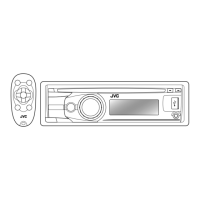What to do if SSM automatic presetting does not work on JVC Car Receiver?
- LLinda MorganSep 16, 2025
If SSM automatic presetting does not work, store stations manually.

What to do if SSM automatic presetting does not work on JVC Car Receiver?
If SSM automatic presetting does not work, store stations manually.
What to do if my JVC KD-R816 Car Receiver does not work at all?
If your JVC Car Receiver isn't working, try resetting the unit.
Why does my JVC Car Receiver display “Please Eject“?
The “Please Eject” message may appear on the display due to overheating. Try ejecting the disc or changing to another playback source.
Why is my JVC Car Receiver generating noise?
If noise is generated, skip to another track or change the disc. Ensure that you do not add the extension code or to non-MP3 or WMA tracks.
Why is my JVC KD-R816 displaying the wrong characters?
This unit can only display letters (capital: A – Z, small: a – z), numbers, and a limited number of symbols.
Why is my JVC Car Receiver displaying “Read Failed“?
If “Read Failed” appears on the display, the connected USB device is not working properly. Connect the USB device again.
Why does my JVC KD-R816 Car Receiver display “Restricted“?
If “Restricted” appears on the display, check whether the connected iPod/iPhone is compatible with this unit.
Why is my JVC Car Receiver iPod not turning on or not working?
If the iPod does not turn on or work: * Check the connecting cable and its connection. * Update the firmware version of the iPod/ iPhone. * Charge the battery of the iPod/iPhone. * Reset the iPod/iPhone. * Check whether the setting is appropriate.
What does “Reading” keeps flashing on the display on my JVC Car Receiver mean?
When “Reading” keeps flashing, note that the readout time varies depending on the USB device. Avoid using too many hierarchy or folders. You can also try turning the power off and on again. Do not pull out or connect the USB device repeatedly while “Reading” is displayed.
Why is my JVC KD-R816 Car Receiver displaying “Not Support” and track skips?
If “Not Support” appears and the track skips, skip to the next track encoded in an appropriate format or to the next non-copy-protected WMA track.
| Power Output | 50W x 4 |
|---|---|
| RMS Power | 22W x 4 |
| Tuner | AM/FM |
| CD Playback | Yes |
| USB Input | Yes |
| Bluetooth | Yes |
| Display | LCD |
| Subwoofer Output | Yes |
| AUX Input | Yes |
| HD Radio | No |
| iPod/iPhone Compatibility | Yes |
| Android Compatibility | Yes |
| MP3 Playback | Yes |
| WMA Playback | Yes |
| FLAC Playback | No |
| Remote Control | Yes |
| Detachable Faceplate | Yes |
| Channels | 4 |
| Equalizer | 3-band |
Crucial safety information regarding Class 1 laser product usage and potential hazards.
How to turn the unit on/off, change input sources, and adjust audio volume.
Methods for tuning into radio stations manually or using automatic presets.
Steps for entering the PIN code and verifying successful device pairing.
Instructions for initiating, receiving, and ending phone calls using Bluetooth.
Steps for copying, searching, and selecting contacts from the phonebook.
Handling incoming calls, ending conversations, and adjusting call volume.
Handling text message alerts and controlling music playback from Bluetooth audio devices.
Interpreting and resolving common Bluetooth connection error messages.
Navigating menus to find and select specific audio tracks on the device.
Saving personalized EQ and tone settings as a user-defined mode.
Choosing preset or custom colors for illumination zones.
Defining user-specific colors for day and night display modes.
Specifications and limitations for playing MP3 and WMA audio discs.
Details on supported audio file formats and playback from USB storage.
Resolving common problems with unit operation, sound, and radio reception.
Solutions for issues related to disc playback, recognition, and interruptions.
Addressing playback errors, format compatibility, and file naming conventions.
Resolving issues with USB device detection, connection, and read errors.
Addressing problems with the unit finding and pairing with Bluetooth devices.
Resolving poor audio quality, echo, and issues controlling calls via Bluetooth.
Resolving iPod/iPhone power, connection, and compatibility problems.
Addressing sound distortion, noise, playback stops, and file errors with iPod/iPhone.
Essential safety information and guidelines before installing the unit.
Diagrams showing connections for microphone, speakers, amplifier, and power leads.
Solutions for common electrical problems like blown fuses or no sound.
